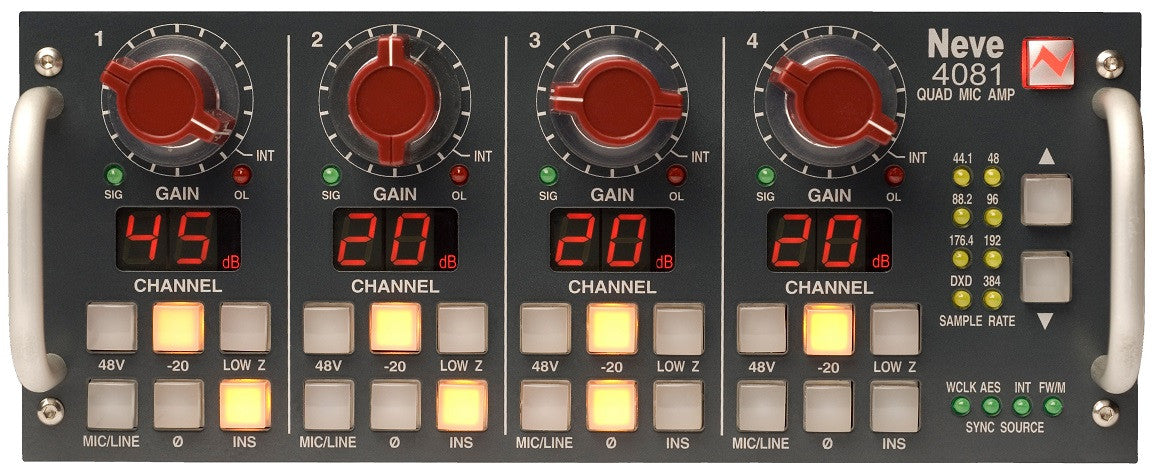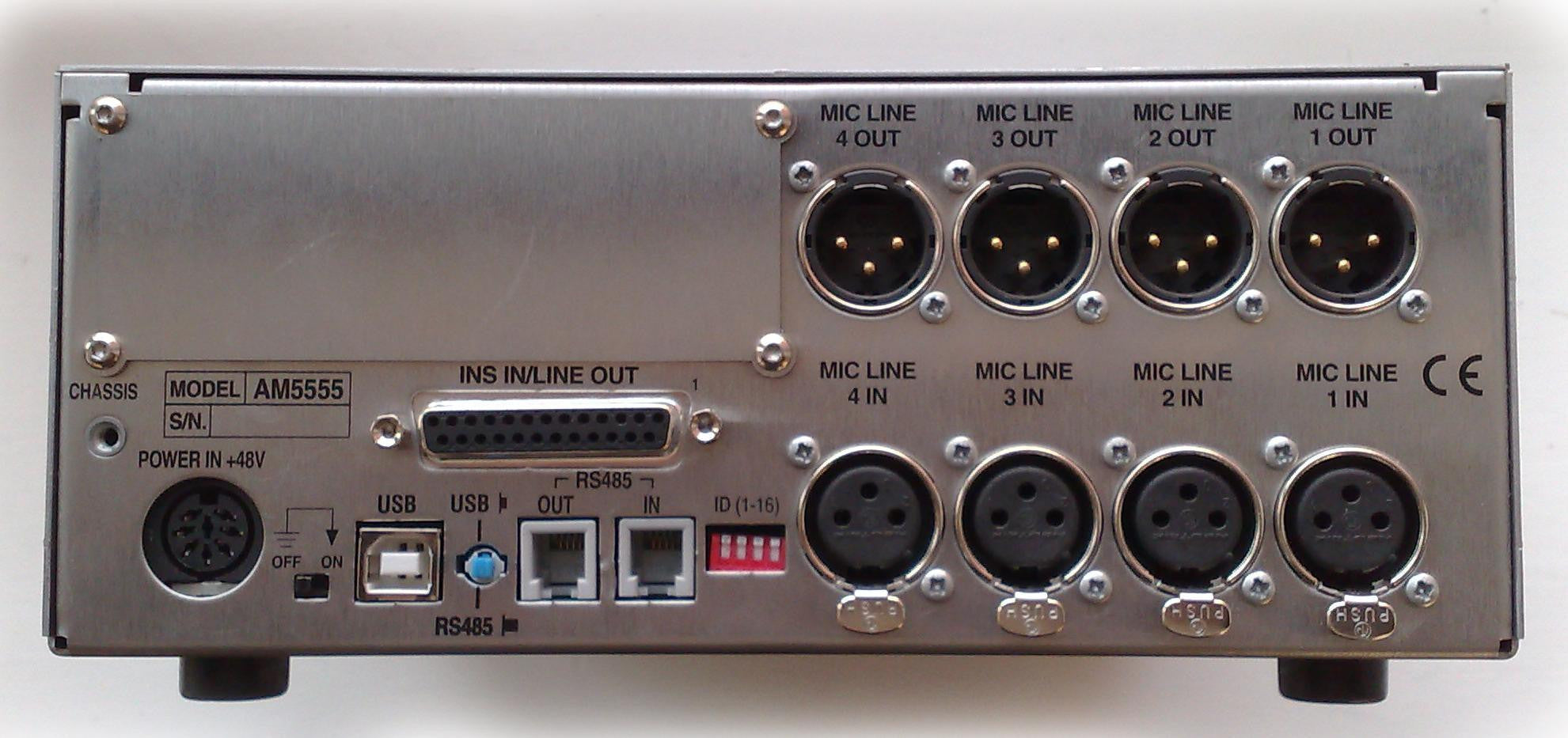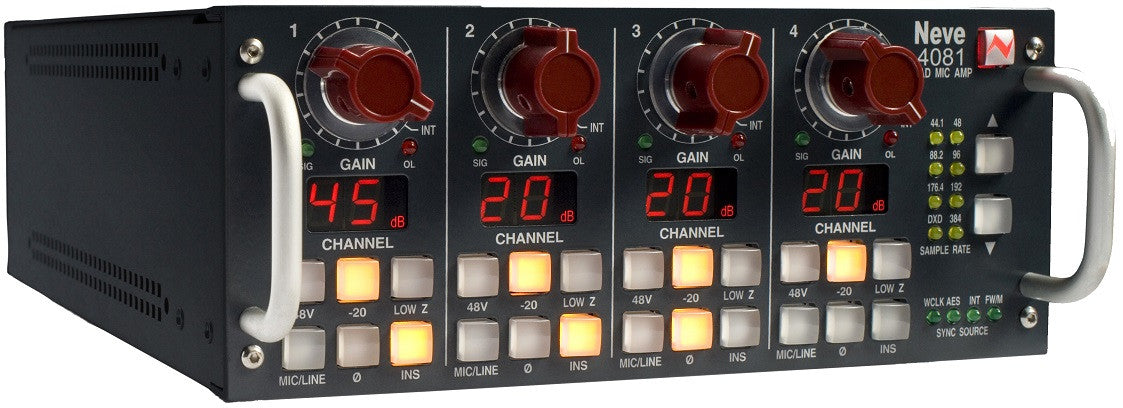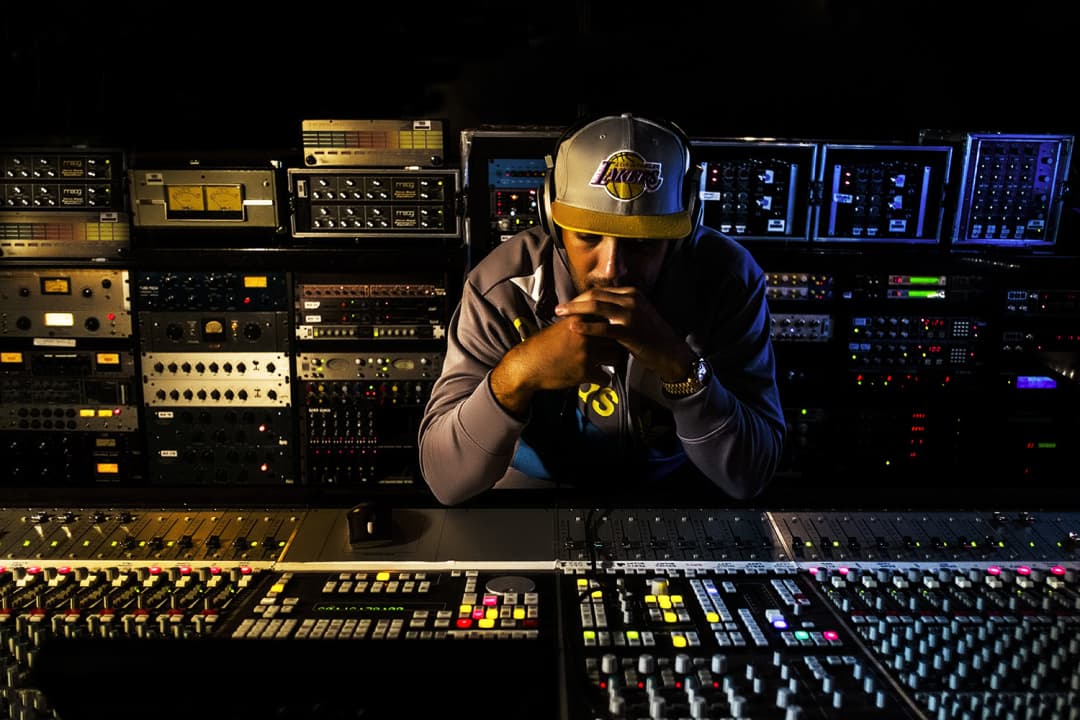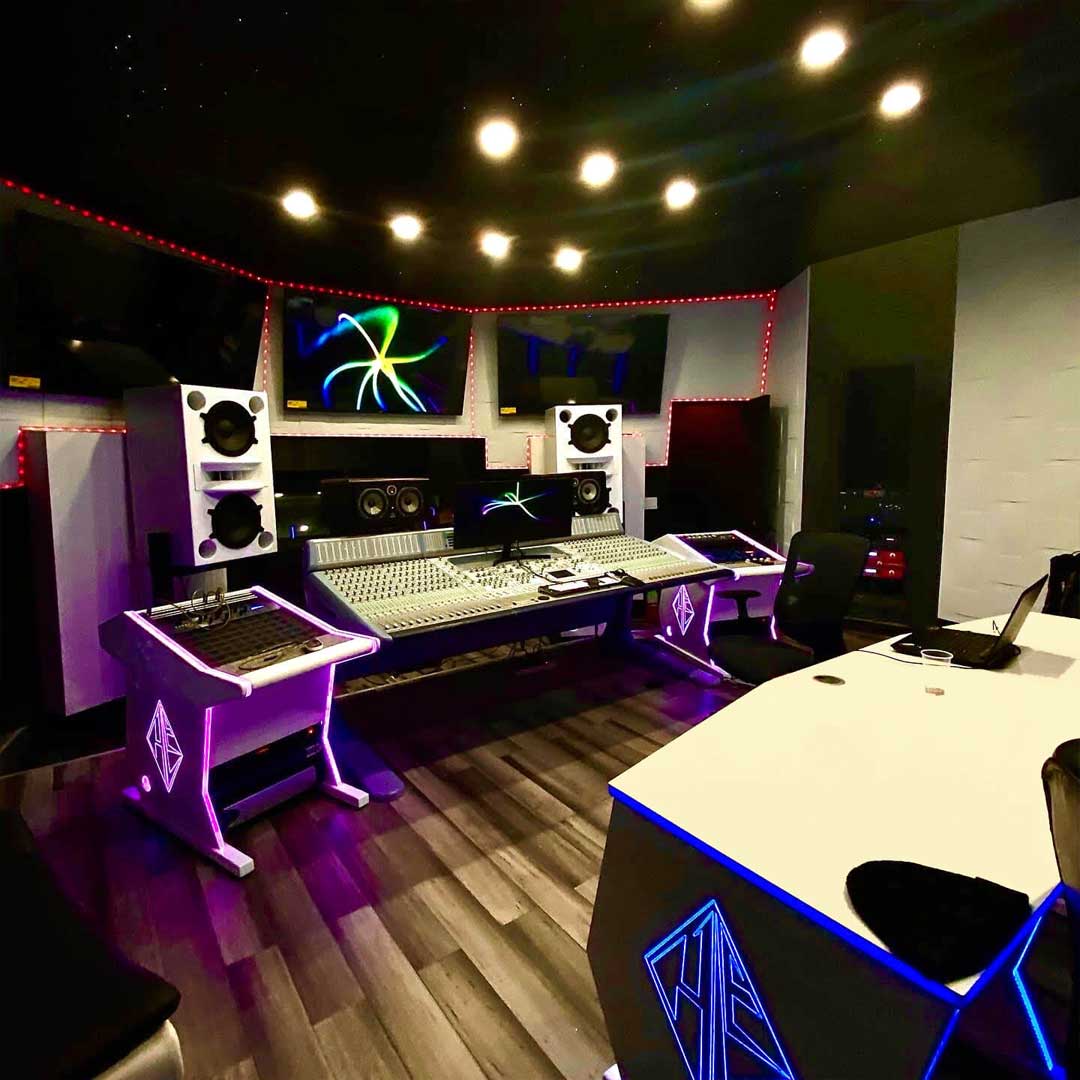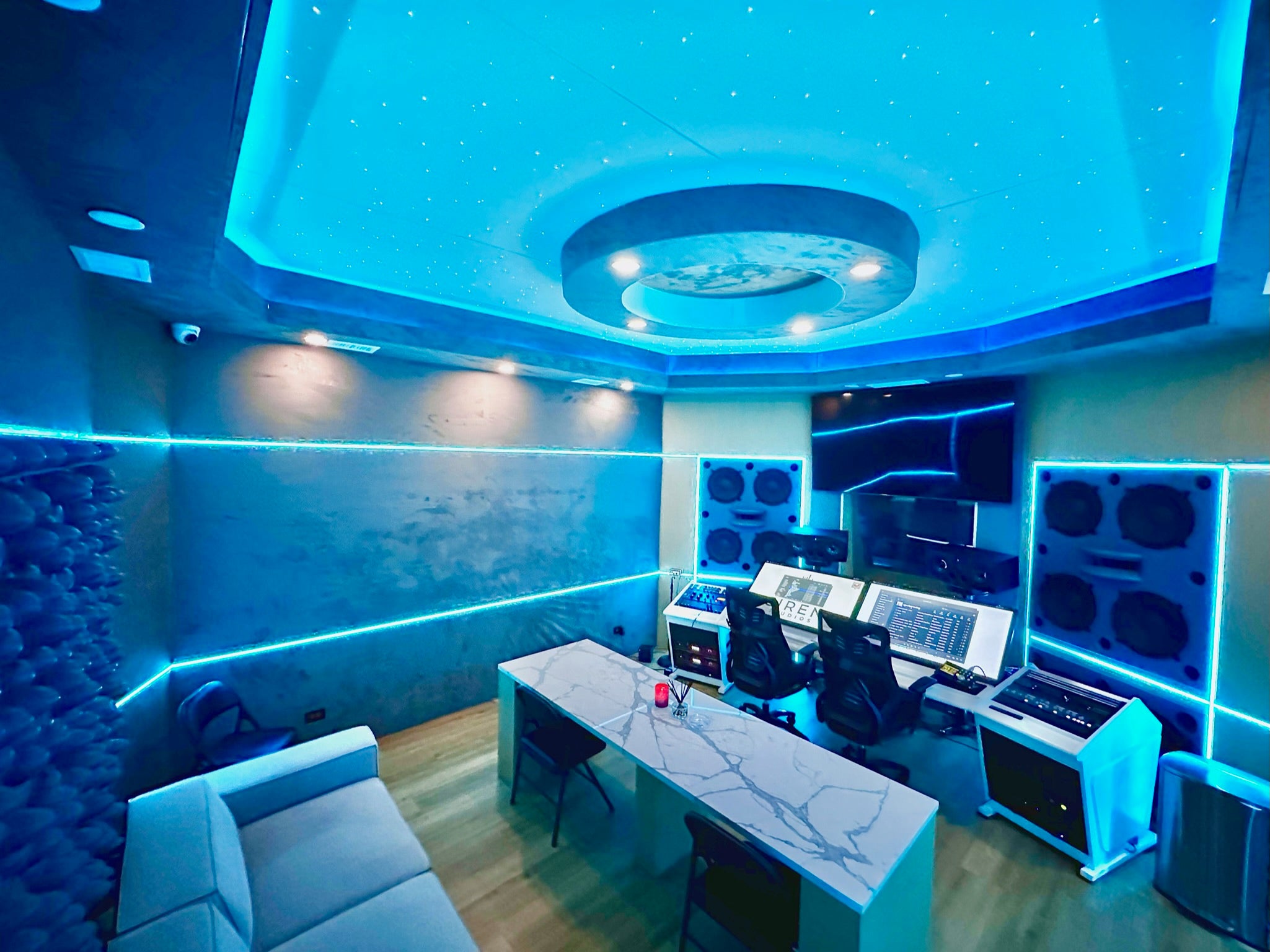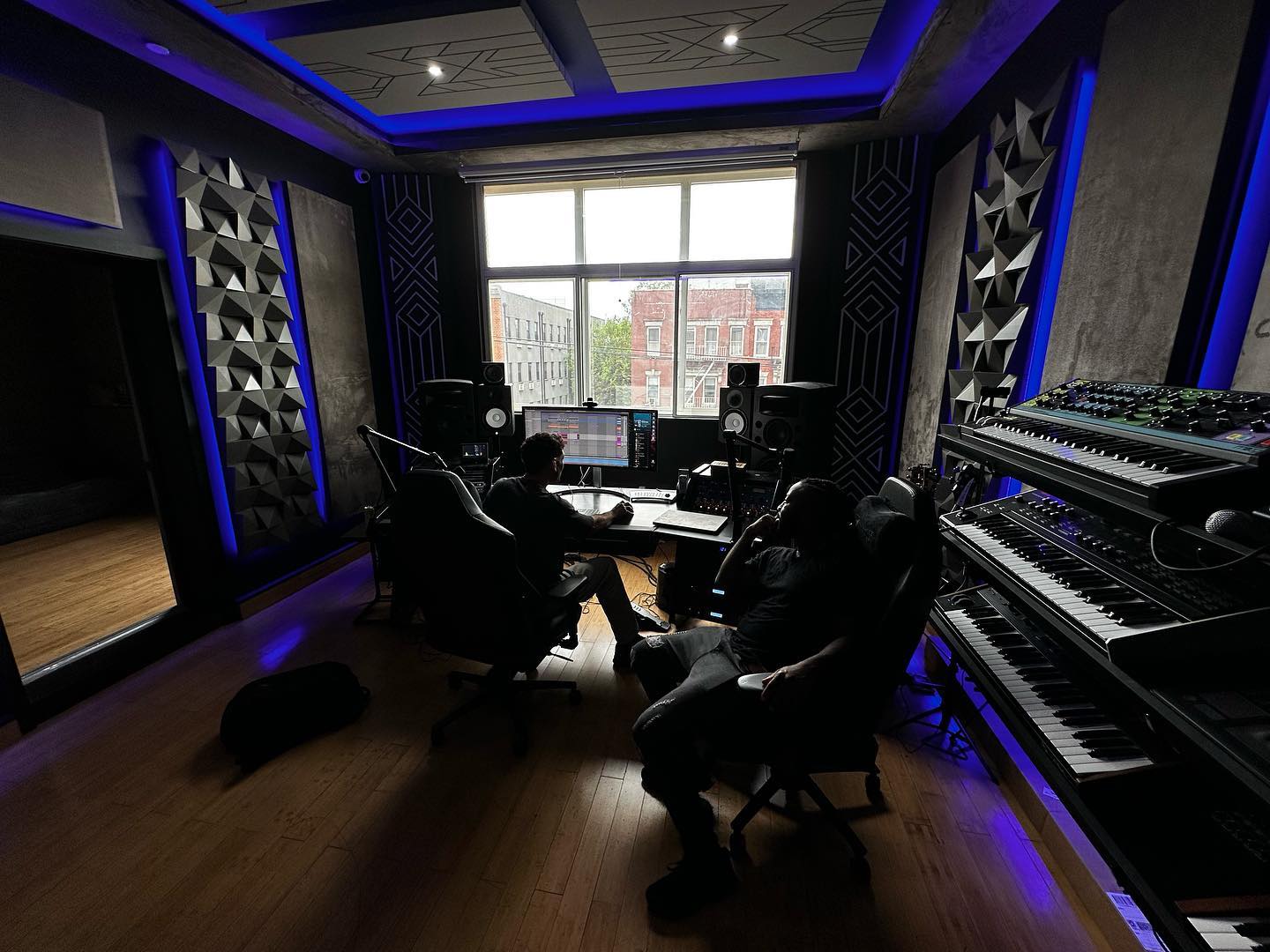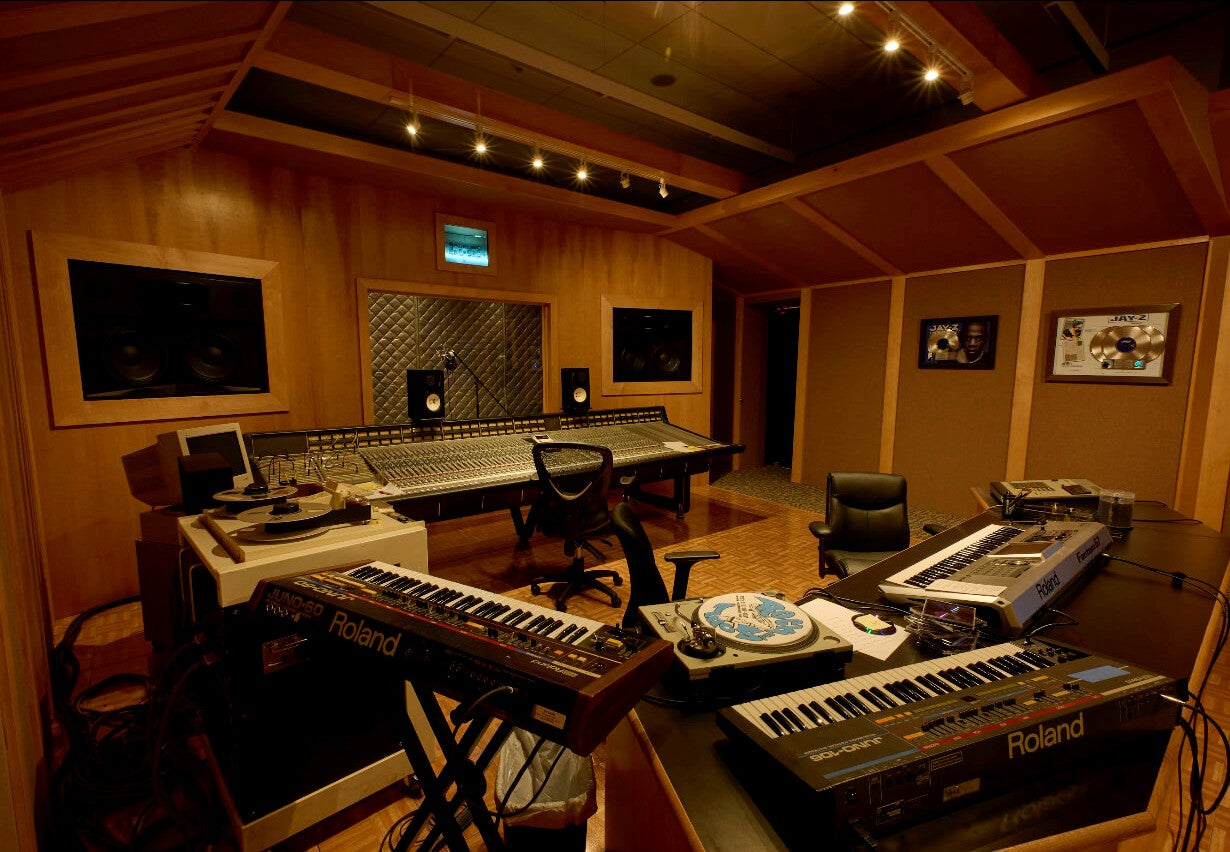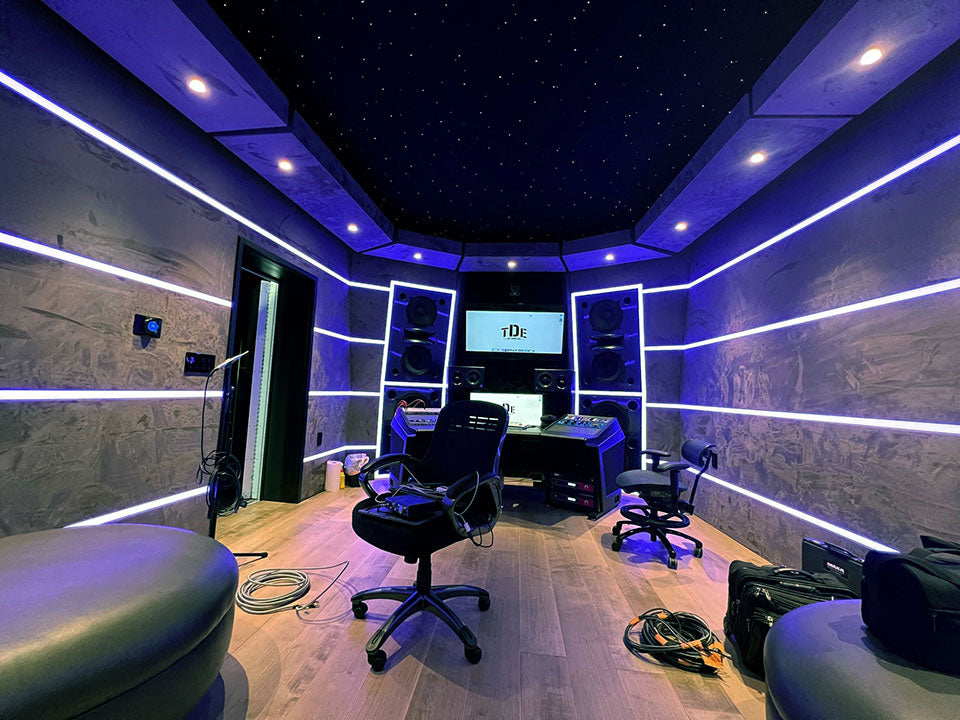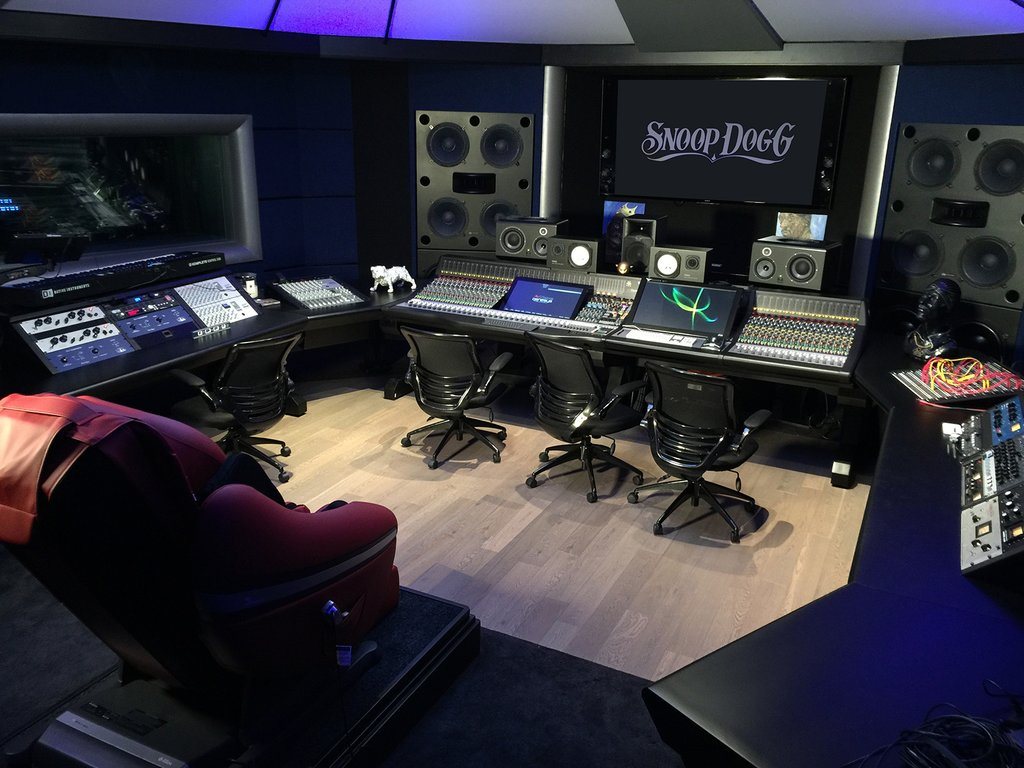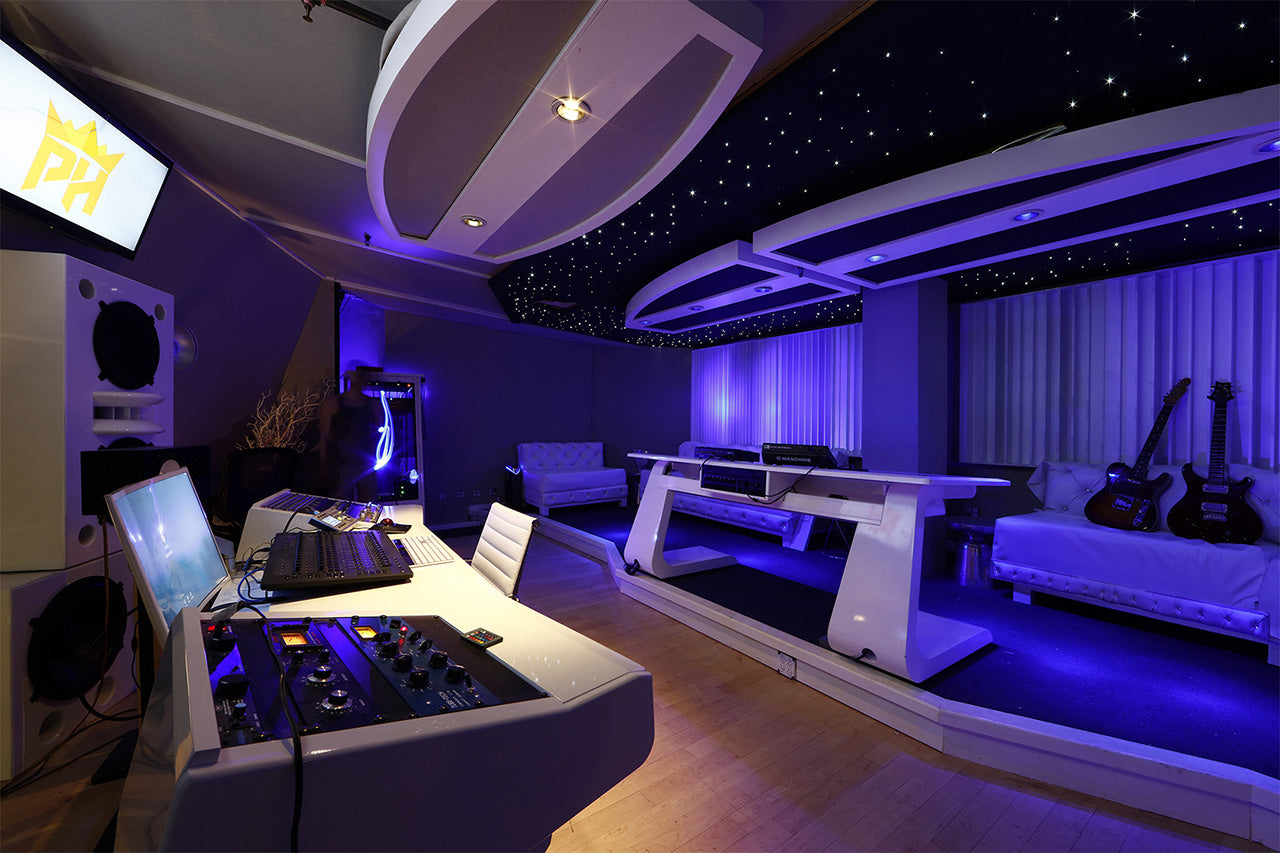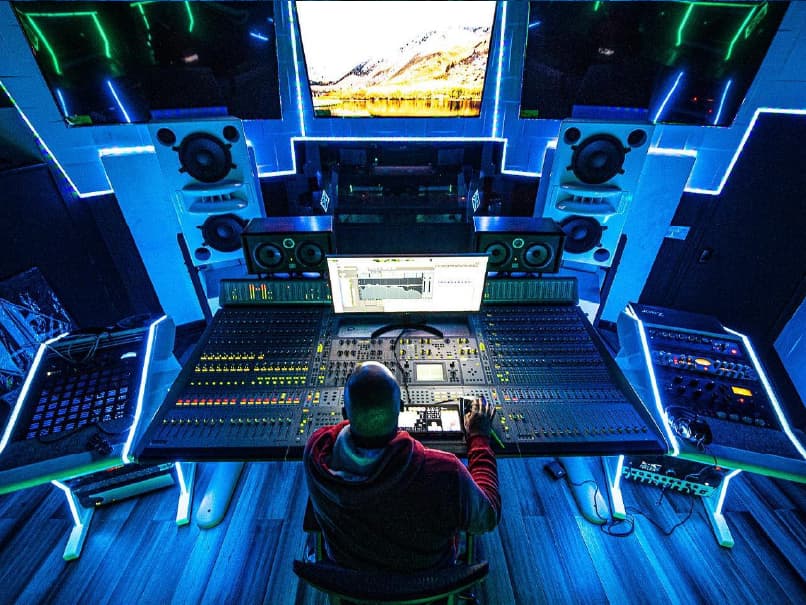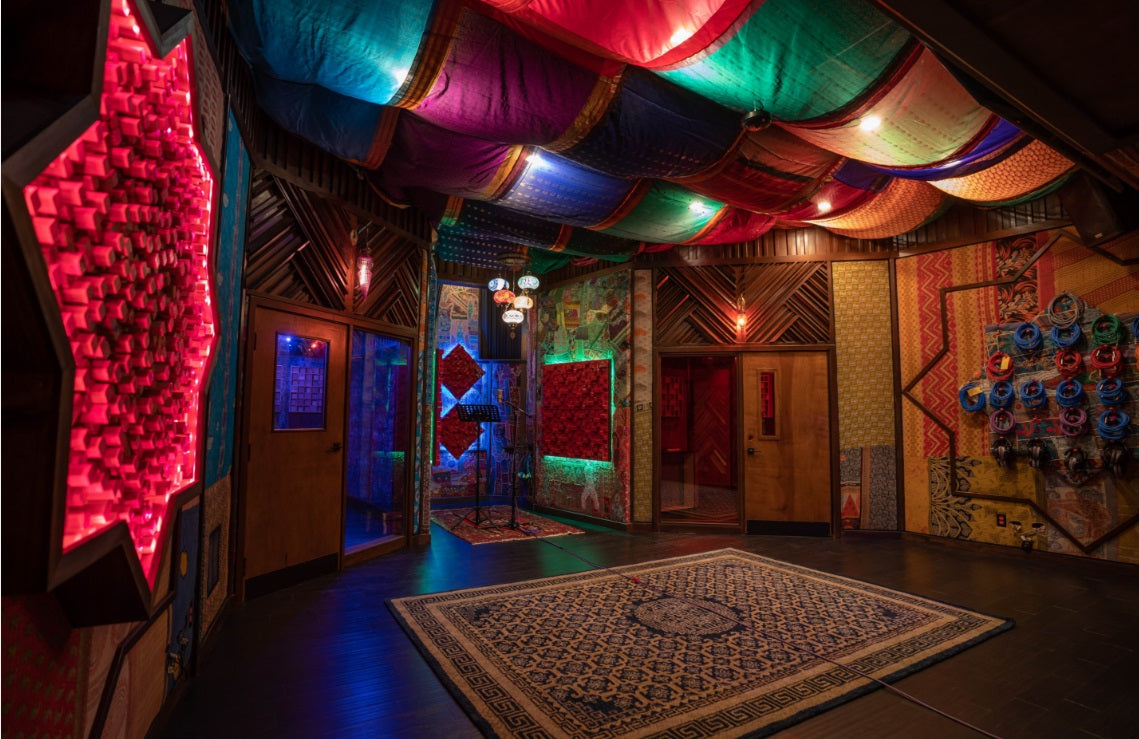The AMS Neve 4081 Quad Mic Preamp is a four-channel mic/line preamplifier based on the classic 1081 modules with remote control capabilities.
Taking its cues from the highly successful 1081R remote preamp rack, the AMS Neve 4081 Quad Mic Preamp comprises four 1081 preamps in a single unit. All functions of the 4081 can either be controlled directly from the front panel or remotely via Mac/PC with Neve Remote Control software. With this configuration you have the ability to control the preamp's gain and settings directly from Pro Tools, Nuendo, Cubase, and other DAWs; the 4081 Neve Remote Control software in standalone on the DAW; the 4081 software on an AMS Neve Genesys/Genesys Black console; or the hardware controls on the 4081 front panel itself. Plus, with the ability to link up to 16 Quad units to create up to a remote system with 64 individual channels, you can conveniently record with the preamps as close to the source as you like*-all this and classic Neve sound-it doesn't get better than that.
AMS Neve 4081 Quad Mic Preamp-Just the Facts:
- Remote control of legendary Neve microphone preamp design
- Four genuine 1081 Mic preamp channels in a single 9-1/2" wide unit
- Two units can be linked together to provide 8-channels in a 19" unit with the optional rack-mount kit
- Remote control using a Mac or PC with Neve Remote Control software
- XLR Mic input can be switched between mic and electronically balanced line
- Switchable 48V phantom power supply
- Digital I/O Option: FireWire/AES interface with four channels of A/D conversion to either AES or FireWire and 4 channels of D/A conversion. Analog insert (pre-A/D converter) per channel
*PAD-For the Record: According to Mr. Rupert Neve, the optimal recorded sound is achieved by having the shortest signal path between microphone and recording device with the least amount of solder connections and junctions possible. Applying that thinking to console design, the A4792 console designed by Rupert Neve for the late Sir George Martin's AIR Montserrat studio, featured remote-controlled preamps that could be placed near the sound source and operated from the desk-a truly radical feature in 1977.
AMS Neve 4081 Quad Mic Preamp-Under the Hood
The mic preamp circuitry is very close to the classic 1081 design of the early 1970s using the same transformer, capacitor types, and other components wherever possible. The modules provide transformer-balanced XLR mic inputs to balanced line outputs. A four‑way DIP switch on the rear panel provides the means of uniquely identifying each 4081 module in a multi‑module installation.
The 4081 always powers up with all settings, levels, and states as they were at power-down. Plus, with version 2.0 software, metering information is passed from the 4081 and displayed within the Remote Mic Control window running on the computer. A 19" rack-mount kit is also available and can be used to securely mount one or two 4081 units into a 19" rack enclosure.
Digital option module
This optional module fits into the rear panel slot (covered by a blank panel) of the 4081. It has two FireWire ports, word clock sync in and out, and a 25-way D-type connector for AES in/out. Without the option module, the sample rate LEDs and buttons on the front of the unit will not function.
The AES in/out and FireWire ports are intelligent. If a FireWire connection is detected, then the 4081 will presume that FireWire will be the digital interface and not the AES. If a FireWire connection is not detected, then the 4081 will presume the audio is coming in via the AES in/out 25-way D-type connector.
Optional 4-channel ADA expansion module
AES signals going into AES In/Out connector (or FireWire if detected) will also be sent as analog outputs from the line out of the D-sub connector
If INS is selected on a channel, then the corresponding analog input signal connected to Ins In of the D-sub connector will be converted and output as AES signals from the AES in/out (or FireWire if detected)
By default, the Post- gain amplified signal from the Mic/Line input will also be routed to the A/D inputs
By default, the unit powers-up with all functions locally controllable, and with all settings and switch states fully recalled as they were at power-down
Front-panel control available on each input:
- 48V: Turns on Phantom Power to the Mic (not available for line)
- -20: Pad, attenuates the incoming Mic signal by -20dB (not available for line)
- Low Z: Impedance for Ribbon Microphones (not available for line)
- MIC/LINE: Selects between the Mic or Line input.
- Ø: Swaps the incoming phase of the Mic or Line signal.
- INS: This selects the source for the A/D in the FireWire expansion module if fitted. When illuminated, allows an external Insert Pre- the A/D of the expansion module.
Gain Control
Turning the gain control will vary the gain as shown in the display beneath.
The Gain level is not related to the actual position of the knob, which will infinitely rotate. The gain knob also has a push-switch which will only function if the unit is attached to an AMS Neve 88R console where it is used to interrogate console control settings (to be implemented in V3.0 software).
Standalone Mode 1 (No FireWire Detected)
This mode is designed for operation with Pro Tools or any other digital system that uses AES/EBU as its digital I/O interface. It provides four mono ADC channels (from the 4081) to AES/EBU over two stereo AES/EBU ports and is compatible with sample rates up to 192kHz on each of these AES/EBU ports (true stereo single wire 192kHz operation). As an added feature, it also has two stereo AES/EBU ports to four DAC channels which can be used for monitoring. Again, these can run at up to 192kHz (true stereo single wire 192kHz operation).
Control of the sampling frequency and synchronization source in standalone mode is done entirely through the front panel buttons. As a general rule, any flashing led on the digital panel shown below indicates that the unit is not locked to the selected sample rate or source. If this happens, please check that the sample rate selected on the 4081 matches that which is being supplied, either by AES, Word clock or FireWire.
Solid LEDs indicate the unit is locked to the selected source at the chosen rate.
The four analog outputs from the 4081 Mic Pre or Insert are mapped to the two stereo AES outputs. The two stereo AES inputs are mapped to the four analog outputs; these are simply an AES to analog converter. The four analog outputs are also available on the DB-25 on the back of the main 4081 unit.
If no sync input is detected (either word clock or AES), then the expansion board runs on internal sync and the sample rate is selected by the Up/Down buttons on the front panel. If a valid sync input is detected, then the sample rate is automatically calculated and indicated on the front panel.
Mode 2 (FireWire Detected)
Multiple 4081 units can be cascaded onto one FireWire stream, or via star configuration back to the FireWire card. There is currently a limit in the driver of four units per FireWire stream. Four units give 16 In and 16 Out on a single DAW connection if using FireWire. However, the available bandwidth allows 16 in and 16 out at 192kHz.
FireWire mode allows the 4081 to be directly connected to a DAW that supports FireWire (for example Logic or Reaper) and provides four mono ADC to FireWire, and four mono FireWire to DAC channels directly from the DAW.
As an added feature, the four ADC channels are also routed to the two stereo AES/EBU ports when in FireWire mode, allowing the 4081 to simultaneously be connected to the FireWire DAW and an AES/EBU I/O system, such as Pro Tools.
In FireWire mode, unfortunately, it is not possible to simultaneously route the AES/EBU inputs to the DAC outputs as they are reserved for the FireWire.
What the Pros are Saying About the 4081
“I recorded a flute, violin, and voice with it and the quality of sound was incredible. The recordings I was able to achieve had an “immediate” quality to them with an incredible depth of sound – I won't be recording anything without the 4081 as the front end from now on.” -Toby Wood, Recording Engineer
“I do most of my work in Parr Street Studios in Liverpool, after doing my first session (I am a session Drummer) I proceeded to go home and purchase my first Neve product (4081) since then my passion for studio engineering and more so production has really skyrocketed.”-Alec Brits, Session Drummer.
Whether it's vocals, ADR, or Foley recording, the features of the AMS Neve 4081 make it the number one choice for any studio, OB truck, or live stage environment. For more information, call or chat online with your PAD Studio Integrator.
Specifications
- Mic Input: XLR input, Z in 1k ohm @ 1kHz
- Mic gain +20 dB to +70 dB in 5dB steps
- Line gain: 0dB to +20dB in 5dB steps
- Maximum mic input level (with pad): +24dB
- Outputs: Max +26dB into 600 ohms, Z out 50 ohms +/-5% @ 1kHz, balanced
- Distortion: <0.07% for 20dBm output from 50Hz to 10kHz @ 60dB Gain
- Equivalent Input Noise: >-123dBm 20Hz to 20kHz @ 60dB Gain
- Line Input: Z in 50k ohm, unity gain, electronically balanced
Power Requirements:
- External power supply rated voltage: 100 – 240V AC
- External power supply rated frequency: 50 - 60 Hz
- External power supply rated current: 1.9A Max
- Input voltage: 48V DC
Dimensions:
- 19" rack mount: 2 units plus fixing brackets
- Height: 3-1/2" (88.2 mm)
- Width: 8-1/2" (218 mm)
- Depth: 10-1⁄2" (267 mm)
